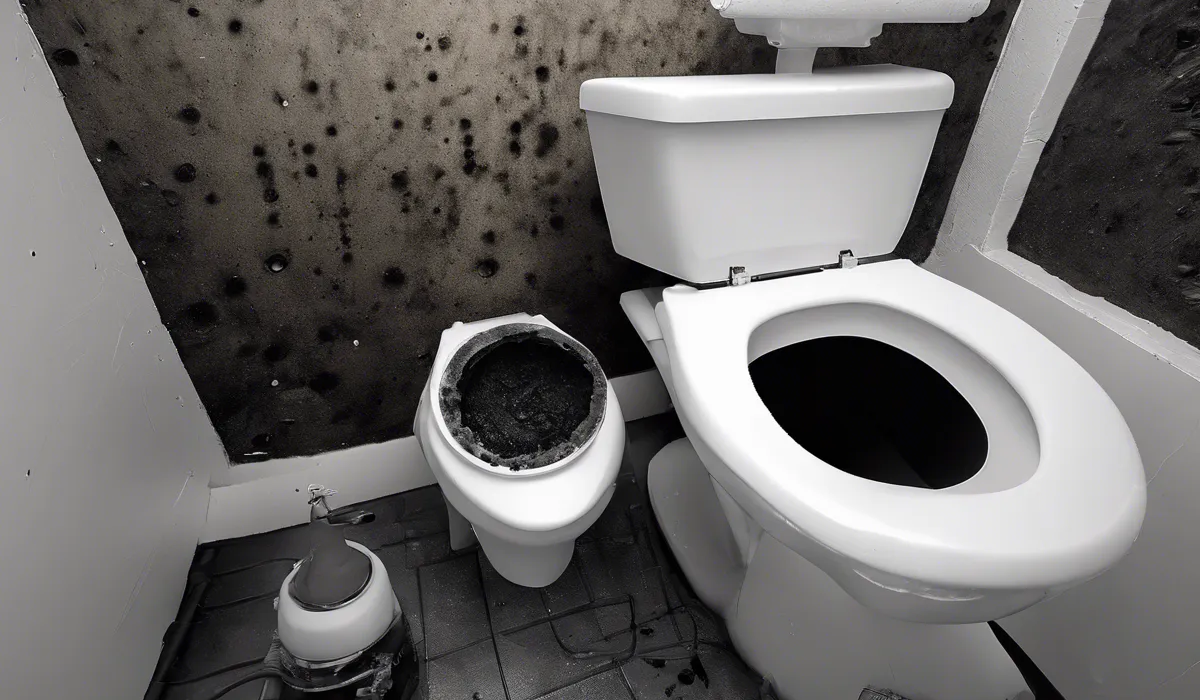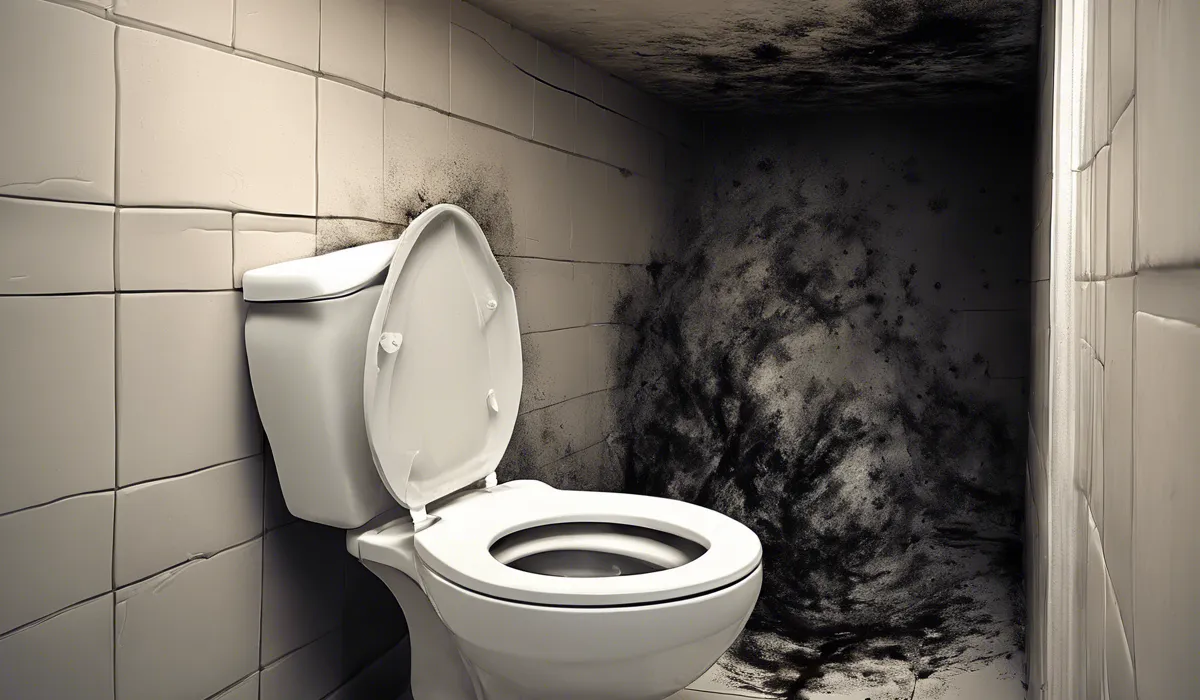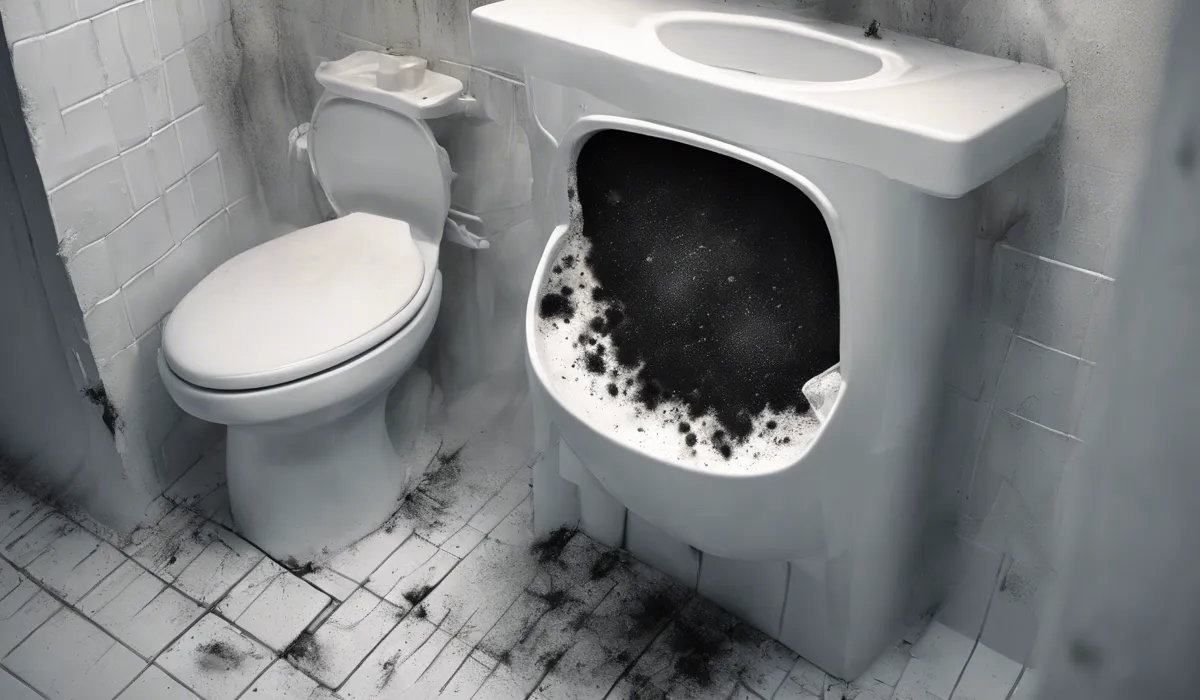Black mold in a toilet tank can be dangerous as it may release spores that cause respiratory issues or allergies. Regular cleaning and ventilation reduce the risk of mold growth. If present, it should be removed carefully using appropriate cleaners.
Understanding Black Mold in Toilet Tanks

What is Black Mold (Stachybotrys chartarum)?
Black mold, scientifically known as Stachybotrys chartarum, is a type of fungus that thrives in damp, dark, and humid conditions.
It appears as a black or dark greenish-black growth and can be found in various parts of homes, including toilet tanks.
This mold is infamous for its ability to produce toxins, which can be harmful to humans and animals.
The Perfect Conditions for Mold
The toilet tank creates an ideal environment for black mold to grow. It is typically dark, moist, and not often cleaned or exposed to sunlight.
Mold spores, which are always present in the air, can easily find their way into the toilet tank and start to multiply when they land on a wet surface.
Neglecting regular cleaning or having poor ventilation in the bathroom can increase the risk of mold growth.
Recognizing Black Mold in Your Toilet Tank
Identifying black mold in your toilet tank can be straightforward. You might notice a black, slimy or fuzzy growth along the waterline or on other wet surfaces inside the tank.
There could also be a musty or earthy smell coming from the toilet, which is a common sign of mold presence.
If you see or smell something that could be mold, it’s important to take action quickly.
Health Risks Associated with Black Mold

Potential Health Problems from Black Mold Exposure
Exposure to black mold can lead to various health issues, particularly affecting the respiratory system.
Some people might experience allergy-like symptoms, such as sneezing, coughing, itchy eyes, and skin rashes.
In more severe cases, exposure can lead to serious conditions like asthma exacerbation or other respiratory infections.
The Toxins Produced by Black Mold
Black mold can produce mycotoxins, which are toxic substances that can cause health problems when humans or animals are exposed to them.
These toxins can be inhaled, ingested, or come into direct contact with the skin. The effects of mycotoxins vary, but they have the potential to be very harmful, especially with long-term exposure.
Symptoms and Issues from Black Mold Inhalation and Contact
When black mold is present in your toilet tank, it can release spores and toxins into the air.
If these are inhaled or come in contact with the skin, they can cause symptoms such as chronic coughing, wheezing, sinus congestion, and skin irritation.
Some people may develop more severe reactions, including nausea, fatigue, and headaches.
Increased Risk for Vulnerable Populations
Certain groups of people are more susceptible to the effects of black mold. These include infants, the elderly, those with compromised immune systems, and individuals with chronic lung diseases.
For these populations, exposure to mold can lead to more significant health complications, making prevention and prompt removal of mold even more crucial.
Prevention and Remediation Strategies

How to Prevent Mold Growth in Toilet Tanks
Preventing mold growth starts with creating an environment where mold cannot thrive. This means keeping your toilet tank clean and dry as much as possible.
Good ventilation is also key, so make sure to use exhaust fans or open windows to reduce humidity levels in the bathroom.
Additionally, inspecting your toilet and fixing any leaks promptly can help prevent mold growth.
Cleaning and Maintenance Practices
Regular cleaning and maintenance of your toilet tank are essential to prevent mold. It’s a good idea to add toilet tank cleaning to your household cleaning routine.
This can be as simple as flushing a cleaning agent through the tank or wiping down the inside of the tank with a cleaning solution.
Natural and Chemical Cleaners for Mold Removal
When it comes to removing black mold, you have the choice between natural and chemical cleaning agents.
Natural options like vinegar or baking soda can be effective for mild mold problems and are less harsh on the environment.
For more severe mold, you might need to use a chemical cleaner specifically designed to kill mold and mildew.
Always follow the instructions carefully and ensure the area is well-ventilated during cleaning.
Seeking Professional Mold Removal Services
If you’re dealing with a significant mold issue or if the mold keeps coming back despite your cleaning efforts, it may be time to call a professional.
Mold remediation experts have the tools and knowledge to safely and effectively remove mold from your home, including hard-to-reach places like inside a toilet tank.
They can also help identify the root cause of the mold growth and suggest long-term solutions.
FAQs About Black Mold in Toilet Tanks
Is black mold in a toilet tank harmful to health?
Yes, black mold in a toilet tank can be harmful as it may release spores that can cause respiratory issues or trigger allergies.
Can black mold in a toilet tank spread to other areas of the house?
Black mold can spread its spores through the air, which can settle in other moist areas and potentially cause mold growth elsewhere in the house.
How often should I clean my toilet tank to prevent black mold?
Regular cleaning, such as monthly, can greatly reduce the risk of black mold growth in your toilet tank.
What should I do if I find black mold in my toilet tank?
If you discover black mold in your toilet tank, it should be removed promptly using appropriate mold-killing cleaners and following safety guidelines.
Does improved ventilation help prevent black mold in toilet tanks?
Yes, improving ventilation in the bathroom can help reduce moisture and humidity, which in turn can help prevent the growth of black mold in toilet tanks.
Final Thoughts
Black mold in a toilet tank poses health risks by potentially releasing harmful spores that can trigger respiratory issues and allergies.
To mitigate these dangers, it’s essential to maintain regular cleaning routines and ensure adequate ventilation.
When black mold is detected, it’s critical to address it promptly with suitable cleaning agents, ensuring a safe and healthy bathroom environment.
